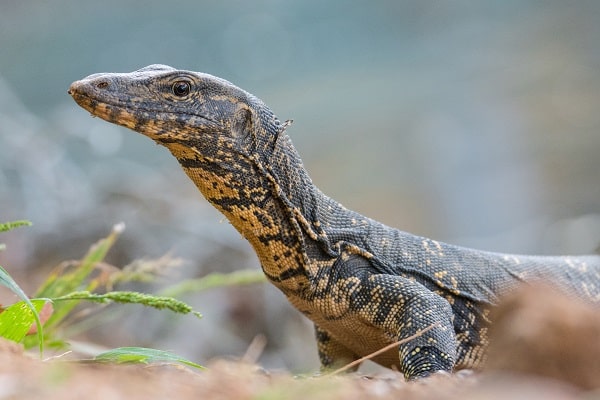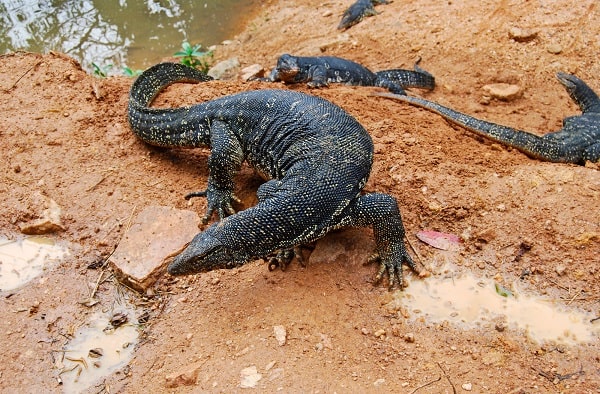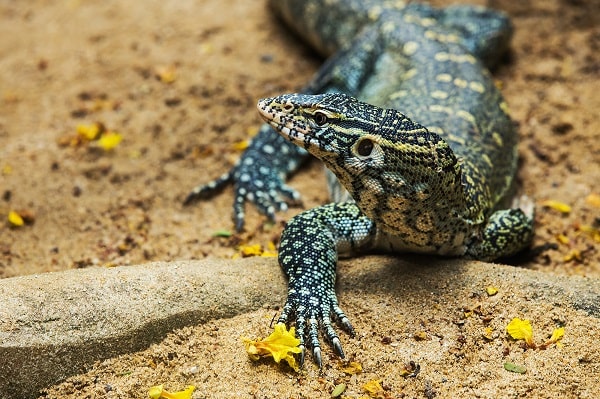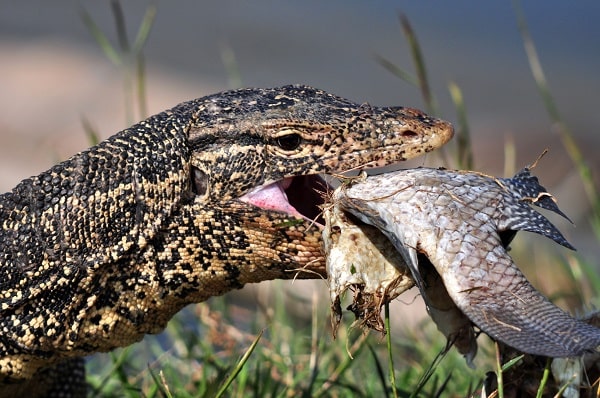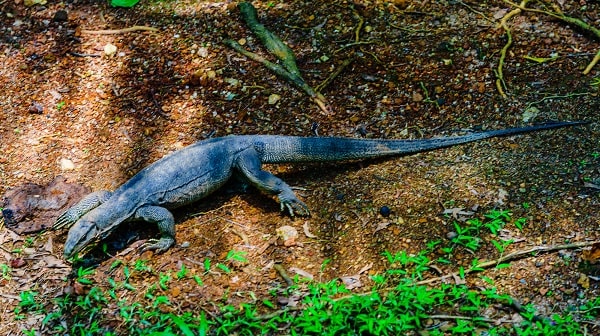The Asian Water Monitor is a popular pet, thanks to its hardiness, adaptability, and prevalence in the wild.
They’re among the smartest lizards (opens in new tab) on the planet, and they’re quite docile compared to many other monitor lizard species.
Tame Water Monitors may learn tricks, bond with their owner, and actively seek human attention and companionship.
While these factors may make this varanid sound like the perfect reptilian pet, there’s one BIG factor that needs to be considered by anyone that’s considering owning an Asian Water Monitor: their SIZE!
Asian Water Monitors are the second-heaviest species of lizard globally, and they’re known to be capable of growing longer and heavier than an average person!
With their large size comes the need for a large enclosure and large amounts of food (more on this later).
And being carnivorous, they aren’t exactly cheap to feed, either.
Still, many keepers argue that Asian Water Monitors make the best pet out of all the giant lizard species when you factor in temperament and intelligence.
If you feel that you may have the time, space, and funds required to care for this gentle giant, keep reading to find out more!
In This Article
Asian Water Monitor Species Overview
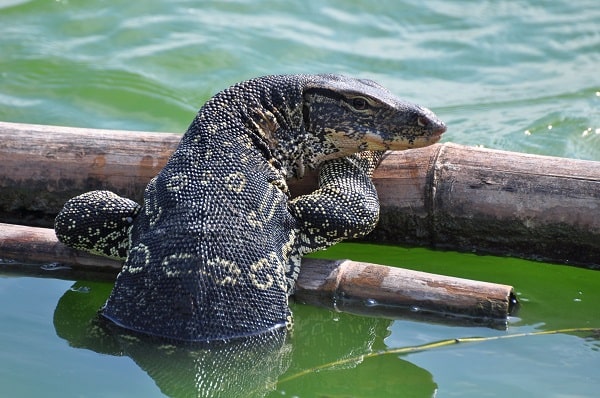
The Asian Water Monitor (Varanus salvator), also known as both the common water monitor and Sumatran water monitor, is a large species of monitor lizard native to South Asia.
As their name suggests, they can always be found near water, so their native environment includes many coastal wetlands and islands.
Asian Water Monitors prefer lowland brackish habitats, especially mangrove swamps and coastal forests.
They’re opportunistic and aren’t easily bothered by human encroachment, so they also thrive in and around farms and city canal systems.
Like most other Varanid species, Asian Water Monitors are known for being intelligent and interactive animals in captivity.
However, their exceptional size and predatory nature require experience, confidence, and caution during handling and interaction.
These large and powerful lizards can defend themselves with their muscular tail, sharp claws, and razor-like teeth.
They’re also opportunistic feeders and eat everything from land-dwelling small mammals, reptiles, birds, and eggs.
Another survival perk of their adaptability is their willingness to eat carrion, which they can smell and track from miles away.
Asian Water Monitor Size
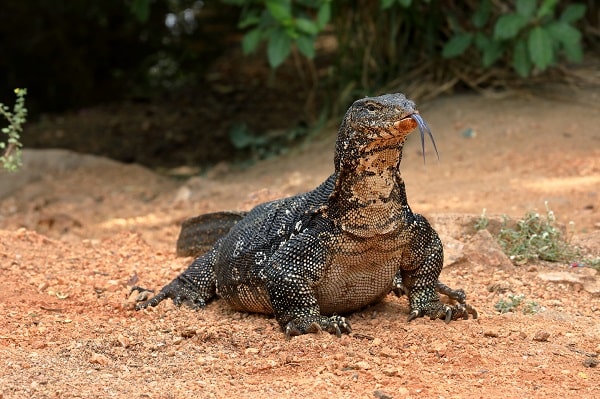
Cute Asian Water Monitor hatchlings start life at only 10 inches long, but they grow quickly.
Although the smaller males are sexually mature at a mere 2 pounds and 16 inches in length, adults have been known to exceed 6 feet in length and 100 pounds in weight.
More typically, mature Asian Water Monitors weigh 20 to 40 pounds and measure 4 to 5 feet long. Their long tail makes up ½ to ⅔ of their total length.
Asian Water Monitor Lifespan
In the wild, Asian Water Monitors only live 10 to 15 years. In contrast, well-cared-for pet monitor lizards can easily live past 20 years old.
Sexual maturity is usually reached by the time the animal reaches 2 to 3 years old.
| Quick Facts at a Glance: | |
|---|---|
| Common name | Asian Water Monitor, Common Water Monitor, Sumatran Water Monitor |
| Scientific name | Varanus salvator |
| Adult size | 48-72 inches (average 48-60 inches) |
| Price | $125-$150 |
| Lifespan | 15-20 years |
| Diet | Exclusively animal proteins including small mammals, reptiles, birds, and eggs |
| Tank Size | 8’ x 4’ x 6’ at minimum |
| Temperature & Humidity | Basking spot: 120-150°F, Warm Side: 80-95°F, Cool side: 80-95°F, Humidity: 60-70% |
| Popular alternatives | Savannah Monitor, Ackie Monitor, Komodo Dragon |
Asian Water Monitor Care
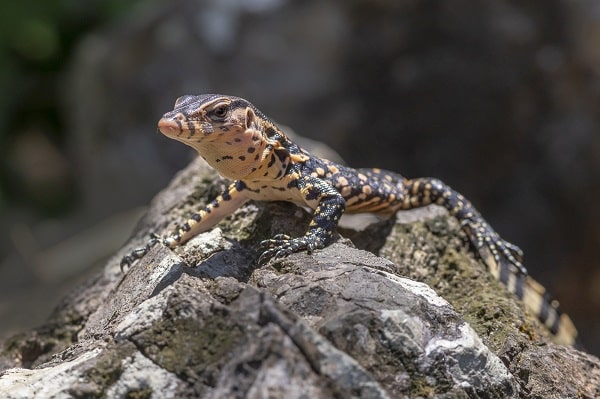
First things first: When it comes to providing the best husbandry for your Water Monitor, ensure you have enough space to house this giant lizard.
Enclosure Size & Dimensions
| Minimum Adult Enclosure Size: | 8’ x 4’ x 6’ |
| Minimum Hatchling Enclosure Size: | 4’ x 1.5’ x 1.5’ |
Your Asian Water Monitor’s enclosure is going to be the most costly and complicated factor of owning this species.
Keep in mind that the dimensions above are only the minimum! More space is always better.
You also need room to create a temperature gradient that allows your pet to rest its whole body mass under a UVB light source, on the warm side, or on the cool side.
You also need space for the various enrichment and exercise opportunities your lizard requires for a long, healthy, and happy life.
Habitat & Enclosure Setup
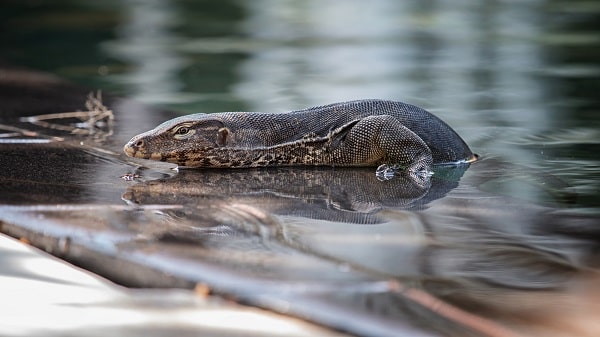
Water Feature
Asian Water Monitors spend much of their time relaxing, exercising, and even defecating in the water. They need a container that’s large enough to submerge entirely and, preferably, actively swim in.
For adult animals, this typically entails using an unconventional container like a bathtub or a trough.
Aside from size, another critical factor is your ability to change the water and clean the container.
Asian Water Monitors instinctively use the water to release their bowels and bladder, so their water will likely need to be changed or otherwise cleaned daily.
Some keepers install a drain on the bottom of the tub and allow the water to flow out, then refill it. Others utilize pricey pond or pool filtration systems. This aspect comes down to your personal preference and budget.
Climbing
Even though Asian Water Monitors are considered semi-aquatic, they also enjoy climbing above ground-level.
As a result, their habitat should include some of the following elements:
- Well-constructed ramps
- Branches
- Platforms
- Poles
- Ladders
- Ropes
- Rope nets
Whatever you decide to use, be sure that your powerful, robust pet cannot break any climbing features because a fall could cause severe injury.
Hides
Hides are especially important for hatchling and juvenile Asian Water Monitors, which tend to feel more fearful and vulnerable than their adult counterparts.
Provide young Asian Water Monitors with at least two hides: one on the enclosure’s warm side and one on the cool side of the enclosure.
The enclosure should be large enough for your monitor to turn around comfortably, but it shouldn’t have much empty space left when the lizard uses it.
Hides are more optional for adult Asian Water Monitors, but they certainly don’t hurt.
Many keepers use commercially made dog houses or build wooden hide boxes.
Some Asian Water Monitors keep moist sphagnum moss inside one of their monitor’s hides to create an area of concentrated, increased humidity.
Substrate
Your Asian Water Monitor’s substrate should hold humidity and allow your pet to practice its natural burrowing and digging instincts.
Most owners use a homemade mixture of topsoil, mulch, and/or leaf litter.
Make sure the substrate is deep enough for your pet to burrow into if it wants: for adults, this means you should keep the substrate 2 to 3 feet deep!
Spot clean any old food and waste material daily.
Every week, till or otherwise fluff up any bedding that has become compacted. You want a moist, airy, fluffy substrate.
Heating & Lighting
Like all reptiles, Asian Water Monitors are ectothermic or cold-blooded, so they require ambient environmental temperatures that facilitate their biological functions.
They also need the option and availability to heat up or cool down their body at will.
This is why you need to provide a temperature gradient, with one end of the enclosure being warm and the other end being cool.
| Temperature & Lighting Summary | |
|---|---|
| Basking Spot Temperature: | 120°F-150°F |
| Warm Side Ambient Temperature: | 85°F-90°F |
| Cool Side Ambient Temperature: | 80°F-85°F |
| Nighttime Temperature Drop (optional): | 72°F-75°F |
UVB lighting for monitor lizards is still a source of debate amongst keepers. While they may not require UVB lighting to survive, most reptile species will thrive with UVB lighting.
The most convenient way to provide UVB is to use a mercury vapor bulb, which offers UV light and heat for basking.
Visible light should be limited to 12 hours per day, maximum.
Follow the packaging directions when setting up your UVB light source.
There are usually guidelines for how far or close you should mount the light from the basking spot. A basking shelf or thick tree branch are excellent choices for the basking spot.
Humidity
Ideal Humidity Level: 60-70%
Asian Water Monitors are a tropical species, so they need high humidity inside their enclosure.
The easiest way to maintain a high humidity level is to keep the large water container under or near the heat source and keep the substrate moist.
Still, the enclosure needs to have adequate ventilation, and you shouldn’t allow the humidity to climb too high.
In fact, stagnant, moist air can cause respiratory infections, scale rot, and mold growth.
Food & Diet
Asian Water Monitors are carnivorous and eat a diet consisting of exclusively animal proteins.
Animals under two years of age have a fast metabolism and are growing rapidly, so they need to be fed as often as once a day or as little as 5 days out of the week.
Once your monitor reaches three years old, its growth will slow down considerably.
Asian Water Monitors are enthusiastic eaters that are prone to obesity, so monitor your pet’s body condition closely and feed accordingly. The standard feeding frequency for adults is 2 to 3 times per week.
Always supplement insects and other non-whole prey sources with calcium and vitamin D3 powder.
Monitor lizards require the roughage found in invertebrate shells, feathers, and fur to keep their digestive system moving appropriately.
You can offer food in a designated feeding dish or off of a pair of tongs. Hand feeding may result in your lizard one day mistaking your pinky finger for a pinky mouse – ouch!
While this species is not picky when it comes to food, here are some of the healthiest options:
- Rodents
- Chicks
- Ducklings
- Roaches
- Crickets
- Mealworms and other larvae
- Canned insects
- Fish
- Shrimp
- Chicken organs
- Eggs
Potential Health Issues
Most monitor lizards, including Asian Water Monitors, are powerful, robust, and healthy animals.
They aren’t particularly prone to many diseases, but the following are some issues you should be aware of.
Obesity
As mentioned previously, Asian Water Monitors have a voracious appetite, so they’re prone to obesity.
Obese animals of any species live much shorter lives.
You can keep your Asian Water Monitor trim and healthy by providing plenty of exercise opportunities, cutting back on feeding frequency as the animal gets older, and feeding low-fat food sources.
Burns
The high basking temperature that Asian Water Monitors require unfortunately puts them at risk for thermal burns from malfunctioning equipment or accidental close contact.
You can avoid burns by keeping your heat sources in a protective cage out of your lizard’s reach and always running heat sources on a thermostat.
Infections
Bacteria and fungus thrive in the same warm, moist environments that your Asian Water Monitor requires.
These organisms can cause various forms of disease, including respiratory infections and scale rot.
Cleanliness and airflow are the best forms of prevention.
Always, always install vents in any enclosure to prevent the air from becoming stagnant.
Remove old food, feces, and urates as soon as you see them since they are the number one contributors to bacteria build-up.
Moreover, the water dish should be scrubbed with a cleaner every week, and the substrate should be changed entirely periodically.
Utilize these opportunities to clean and disinfect the walls and floor of the enclosure.
Behavior & Temperament
Baby Asian Water monitors are typically nervous and flighty.
They detest being restrained and prefer to be left alone.
As they grow older, bigger, and more accustomed to your presence, they will become easier to handle.
Always start slow and don’t force interaction. Offer tasty treats from a tong that you’re visibly holding.
Interact with your Asian Water Monitor as much as possible without over-stressing it. Even sitting in the same room, within its view, allows it to become used to you.
Tamed adult Asian Water Monitors are smart, active lizards that seek out human attention and can even be taught tricks.
But beware that not all monitors are so friendly. The crocodile monitor, for example, is quite dangerous and unpredictable.
Handling Them
Don’t rush the bonding and trust-building process.
You have many years to build a relationship, and that process will be easier if you don’t traumatize your lizard.
Once your monitor seems to be interested in your presence, you can allow it to climb on your arms within the enclosure.
It may take several months of these safe handling sessions before you can begin handling it outside of the enclosure.
When you introduce any new environment or stressor while handling the lizard, always start with short handling sessions and gradually increase to longer handling sessions while exposed to the same stimuli.
If at any time your Asian Water Monitor becomes spooked and panics, you should not attempt to restrain them unless they can escape.
Inside your own home, it’s better to allow them to retreat to whatever cover they can find and give them time to calm down.
Holding onto or otherwise restraining an adult Asian Water Monitor can result in punctures and lacerations severe enough to cause a trip to the hospital.
Appearance & Colors
Like most other monitor lizard species, Asian Water Monitors have elongated bodies, tails, and faces.
They’re incredibly muscular and powerful.
They have sharp talons that they use for escaping, digging up eggs, and self-defense.
Their tail features a unique, fin-like piece of skin to help them navigate their aquatic environment.
Their dark brown or black bodies are covered in keeled scales.
Younger animals feature yellow spots on their bellies that fade with age and maturity.
Another unique marking of this species is the yellow-bordered black band extending from the back corner of their eyes to their ears.
There are also a handful of color morph mutations available in captivity: T+ albino, T- albino, and melanistic, which is also known as “Black Dragon.”
Do Asian Water Monitors Make Good Pets? A Summary
If you were curious about what it’s like to own an Asian Water Monitor, we hope that we’ve been able to answer most of your questions.
Most reptiles are a long-term and involved commitment; giant species like the Asian Water Monitor are even more so.
Most reptile hobbyists don’t have the resources required to house and care for a full-grown animal.
Still, for the select few keepers with the option, Asian Water Monitors make fantastic, personable reptilian companions.
If you’ve decided that you’ve got what it takes, good luck on your Asian Water Monitor ownership journey! If not, keep looking: you’re sure to find the perfect reptile species for you!

